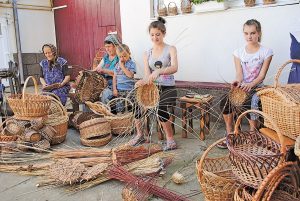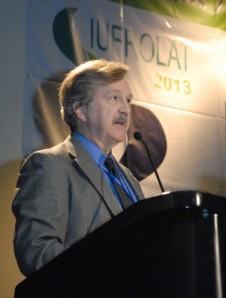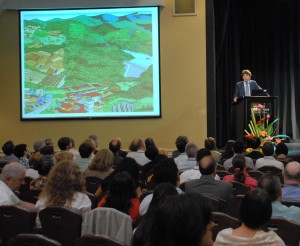IUFRO Spotlight #66 – A forest mix may best address global change
IUFRO Spotlight #66 – A forest mix may best address global change

Managing a mixed forest in the context of environmental and social change is the focus of a recent publication put together by members of IUFRO Research Group 1.09.00 (Ecology and Management of Mixed Forests).
The structure, dynamics and functioning of such forests are increasingly relevant topics for researchers.
Read more…The Future of Forests and Forestry in Asia and the Pacific
A report from the partner event on the opening day of the 27th Session of the Asia-Pacific Forestry Commission by Dr Michael Kleine, IUFRO Deputy Executive Director
The 27th Session of the Asia-Pacific Forestry Commission, taking place at the Bandaranaike Memorial International Convention Centre, Colombo, Sri Lanka from 23-27 October 2017, started with a partner event on the future of forests to be assessed in the forthcoming 3rd Asia-Pacific Forest Outlook Study “The future of forests and forestry in Asia and the Pacific: The path to 2030 and beyond”. Read more…
IUFRO 125th Anniversary Congress Spotlight #47 – Remote forest-dependent communities can benefit through social innovation

The village of Iza in Transcarpathian Ukraine is famous far beyond the region’s borders for its wicker products. Most villagers are involved in the business.
http://ukurier.gov.ua/uk/articles/selo-iza-na-zakarpatti-postachaye-virobi-z-verbi-d/
Many rural forest-dependent communities face similar challenges – lack of infrastructure, housing, and transport as well as aging populations.
When global issues such as climate change, sustainability, and energy and food security are added to the mix, the need for solutions to the challenges becomes much more pressing. Read more…
Bringing science to the people
How IUFRO’s Special Programme for Development of Capacities (SPDC) contributes to enhancing forest science communication within the framework of a Climate Change Adaptation Program in Bhutan.
Would you like to see your forest be wrapped up in plastic? Well, this is what Bhutanese society will witness due to a research project that aims at simulating drought, which may affect the region’s forests in the future as a result of climate change. In order to inflict drought stress on mature trees, entire research plots of considerable size have been covered with plastic roofs in about 2 m height above ground level, preventing rain water from reaching the soil and roots of trees. But would local people show understanding for such a measure and approve of it easily?
IUFROLAT III Keynote Address on 13 June 2013
Forests, Ecosystem Services and Poverty Alleviation: Charting a new research agenda
By Peter Dewees, Forest Advisor, World Bank
The Millennium Ecosystem Assessment defines ecosystem services as the benefits that people obtain from ecosystems. And ecosystem themselves are, speaking in economic terms, an asset, while their services would represent the flow of benefits. So paying for ecosystem services, once the benefits have been valued, has become a topic of interest especially with governments.
Ecosystem services are closely related to poverty alleviation, but it might be just a conventional wisdom to think that the deterioration of ecosystem services automatically leads to an aggravation of poverty. As a matter of fact, there is evidence that human wellbeing has been increasing while the environment and ecosystem services are declining. The Human Development Index illustrates this situation. So what are the underlying causes for this disconnect?
It might be that we are measuring the wrong things and disregard important factors, e.g. the time lag between the decline of ecosystems and the impact.
With regard to forests, global forest cover is declining and forest degradation is increasing for many reasons, yet in some rural landscapes tree numbers are growing. For the farmers, trees are important in many ways. In countries like Kenya, for example, they serve as field boundaries. Trees on farms can increase productivity and thus increase household incomes, they also help build resilience due to diversification of species. Trees on farms can build soil carbon.
So, incorporating trees in land management strategies is an important contribution to climate change mitigation. Consequently, what is really needed is to put in place policies to create incentives for better landscape management. Policies need to be informed by good data, and this is where research comes into the picture and the focus should be on fully recognizing the complexity of landscapes.
The data required should fulfil a set of criteria, of course. They need to be representative, suited for being aggregated, up-to-date, policy relevant and address the right questions.
In conclusion, Dewees particularly points out two research areas that should feature more prominently and deliver good data:
a) The role of household environment income with respect to productivity and consumption; risk and vulnerability; and equality;
b) Policy and public finance with regard to how to support farmer based adaptation and how to identify other points of entry such as social safety nets.
IUFROLAT Inaugural Address: Climate Smart Territories
Jose J Campos, Director General, CATIE, took centre stage once again giving an inspiring presentation entitled, “Climate smart territories- fostering production, resilience and reduced emissions through socially inclusive land management.” He opened by saying that it is important to think and to work on the territorial level. We should strive to optimize the goods and services in a territory, and to craft a vision with the different players in a territory. It is possible to diversify the economy and recover forest coverage, and noted that countries such as South Korea, and Finland are already doing so.
He stressed what is needed is collective actions from stakeholders; to give a positive result in a territory and ensure that we can improve our landscapes. He noted that this will take indigenous knowledge, new technologies, increased research and time, and it is important not to be spontaneous in how we approach the problems.
Key messages from his presentation include:
- Global challenges increasingly threaten human security; climate, food, water, energy, etc.
- System approaches (livelihoods, territorial, sustainable production and value chains) could effectively manage synergies and trade-offs among global challenges.
- There is a need for collective action through effective local governance and co-management of natural resources.
- “Climate smart technologies” are a tool that links top=down and bottom-up actions for collective impact.
He continued to explain that we do not need to reinvent the wheel. We need to find territories and existing projects to use as a model. He finished by saying that the key to this is in future professionals and in new interdisciplinary science. He stated there is a need to link students to ongoing development initiatives through fieldwork and case studies, to link their education to research, to local development processes and their contributions to society. If we work together we can create a virtuous circle for inclusive and sustainable human well-being.



